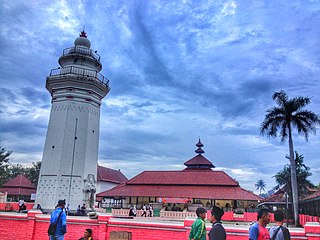
Drax power station is a large biomass and coal-fired power station in North Yorkshire, England, capable of co-firing petcoke. It has a 2.6 GW capacity for biomass and 1.29 GW capacity for coal. Its name comes from the nearby village of Drax. It is situated on the River Ouse between Selby and Goole. Its generating capacity of 3,906 megawatts (MW) is the highest of any power station in the United Kingdom, providing about 6% of the United Kingdom's electricity supply.

The Ferrybridge power stations are a series of three coal-fired power stations situated on the River Aire near Ferrybridge in West Yorkshire, England, next to the junction of the M62 and A1(M) motorways.

Rye House Power Station is a 715 MW combined cycle gas turbine (CCGT) power station close to Rye House railway station in Hoddesdon, Hertfordshire.

Drax Group plc is a British electrical power generation company. The Group is made up of upstream and downstream enterprises. The principal downstream enterprises are based in the UK and include Drax Power Limited, which runs Europe's biggest biomass-fuelled power station, Drax power station, near Selby in North Yorkshire – the UK's largest decarbonisation project, as well as supplying between 7-8 per cent of the country's electricity needs. Related businesses include Haven Power, a supplier of electricity to business. The group's largest upstream enterprises are Drax Biomass, which sources sustainable biomass for Drax power station and Baton Rouge Transit, which handles storage and transport of finished biomass pellets from the Port of Baton Rouge, Louisiana.

The Thunder Bay Generating Station is a biomass-fired power station owned by Ontario Power Generation ("OPG"). It is located on Mission Island in Thunder Bay, on the shore of Lake Superior.
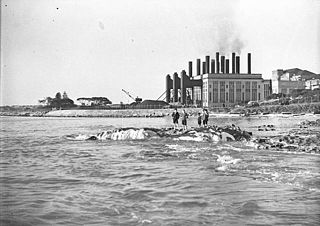
Bunnerong Power Station is a demolished former coal-powered electric power station in the south-eastern Sydney suburb of Matraville, New South Wales, Australia. When the last generating units were commissioned, it was the largest power station in the southern hemisphere, with a capacity of 375 megawatts (MW) from eleven turbo-alternators. It was able to supply up to one third of the state's electricity needs at the time. It remained the most powerful until the completion of Vales Point Power Station in 1966.

Kingsnorth was a dual-fired coal and oil power station on the Hoo Peninsula at Medway in Kent, South East England. The four-unit station was operated by energy firm E.ON UK, and had a generating capacity of 2000 megawatts. It was capable of operating on either coal or oil though in practice oil was used only as a secondary fuel or for startup. It was also capable of co-firing biofuel, up to a maximum of 10% of the station's fuel mix. A replacement power station, also coal-fired, was considered by owners E.ON, but plans were abandoned. The proposed replacement attracted substantial public protests and criticism, including the 2008 Camp for Climate Action.

Littlebrook Power Station is a series of four oil and coal-fired power stations situated on the south bank of the River Thames, next to the Queen Elizabeth 2 Bridge and the Dartford Tunnel in Dartford, Kent. The final power station, Littlebrook D, ceased operating in March 2015. And is now under demolition.

The Tilbury power stations were two fossil fuel power stations on the north bank of the River Thames at Tilbury in Essex. The 1,428 MW Tilbury B Power Station had operated between 1967 and 2013 and fired coal, as well as co-firing oil and biomass. The former oil-fired 360 MW Tilbury A Power Station operated from 1956 until 1981 when it was mothballed. The former system generated enough electricity to meet the electrical requirements of 1.4 million people, equivalent to 80% of the population of Essex.

The Wilton power station refers to a series of coal, oil, gas and biomass fired CHP power stations which provide electricity and heat for the Wilton International Complex, with excess electricity being sold to the National Grid. It is located on the Wilton site in Redcar and Cleveland, south of the town of Middlesbrough in North East England. The station has provided for the site since opening in 1952, when it was operated by ICI. The station is currently owned and operated by SembCorp Industries.
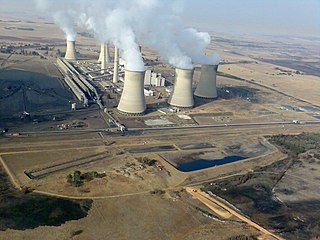
Arnot Power Station in Mpumalanga, South Africa, is a coal-fired power plant operated by Eskom. Coal from the Arnot coal mine directly feeds the station.
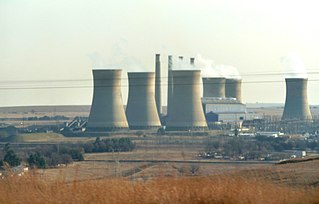
Camden Power Station in Mpumalanga, South Africa, is a coal-fired power plant operated by Eskom.

Burshtyn TES is a coal-fired power plant of Zakhidenergo located in Halych Raion 6 kilometres (3.7 mi) south-east from Burshtyn, Ivano-Frankivsk Oblast, Ukraine. It has two chimneys which were built in 1966 are also used as high-voltage pylon. The plant has 12 units with a total installed capacity of 2,334 MW. It has a 330 kV double-circuit connection to the 750/330 kV substation called ZahidnoUkrainska (WestUkraine).
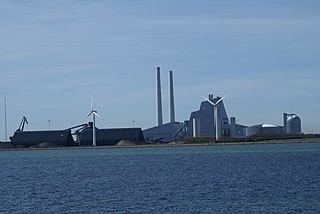
The Avedøre Power Station is a combined heat and power station, located in Avedøre, Denmark, just south of Copenhagen, and is owned by Ørsted A/S. Avedøre Power Plant is a high-technology facility and one of the world's most efficient of its kind, being able to utilize as much as 94% of the energy in the fuel and convert 49% of the fuel energy into electricity. Apart from using coal, petroleum (oil) and natural gas, the plant runs on a wide variety of biomass fuels such as straw and wood pellets. The plant consists of two units with a total capacity of 793 MW of electricity and 918 MW of heat. The combination of producing electricity and heat for district heating at the same time is widely used in Denmark and the rest of Scandinavia, due to the need of domestic heating together with the Danish energy companies putting a big effort into optimising the energy plants.

NTPC Limited, formerly known as National Thermal Power Corporation Limited, is an Indian Public Sector Undertaking, engaged in the business of generation of electricity and allied activities. It is a company incorporated under the Companies Act 1956 and is promoted by the Government of India. The headquarters of the company is situated at New Delhi. NTPC's core business is generation and sale of electricity to state-owned power distribution companies and State Electricity Boards in India. The company also undertake consultancy and turnkey project contracts that involve engineering, project management, construction management and operation and management of power plants.

Sarawak Energy Berhad (SEB) is the Malaysian energy company based in Kuching, Sarawak. The company responsible for the generation, transmission and distribution of electricity for the state of Sarawak in Malaysia. It is wholly owned by the State Government of Sarawak.

Electricity sector in Hong Kong ranges from generation, transmission, distribution and sales of electricity covering Hong Kong. There are two main providers of electricity in Hong Kong.
Basin Bridge Gas Turbine Power Station is a state-owned gas fuel-based power plant located in Basin Bridge, Chennai. It has a capacity of 120 MW and is operated by the Tamil Nadu State Electricity Board.
Cuddalore IL&FS Power Station is a 1,200-megawatt (MW) coal-fired power station in Tamil Nadu, India.

